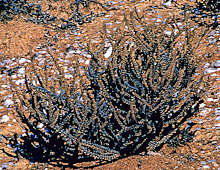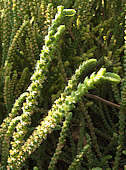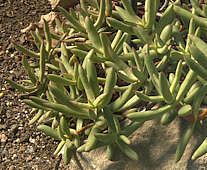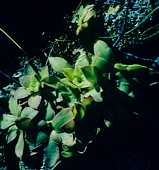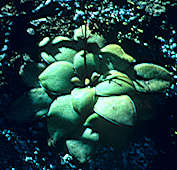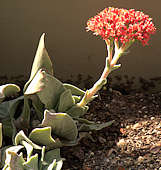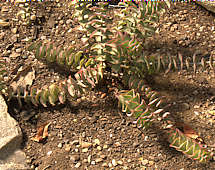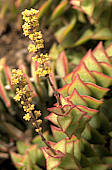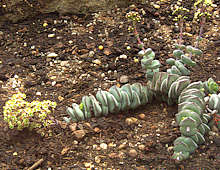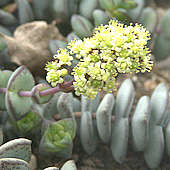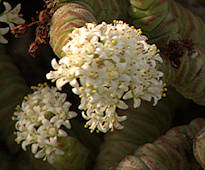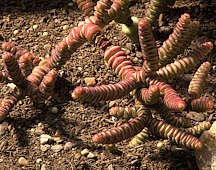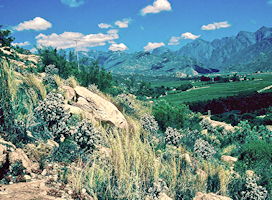 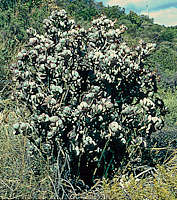 Above: 6ft tall Crassulas Above: 6ft tall Crassulas
on a South African hillside.
Crassula Dillenius 1732
Latin: crassus = thick
The genus Crassula includes around 200 species of succulent plants, ranging in size from less than an inch in height to 6 foot shrubs. Crassulas are distributed throughout the world, although the majority are from South Africa and there are few truly hardy species. The shrubby Crassula sarcocaulis is an notable hardy exception and makes an attractive flowering bonsai-style shrub. Many attractive dwarf Crassulas are available to the collector. Some species are monocarpic and die after flowering, just as the plant achieves perfection.
The best known species is probably C. ovata (Jade Plant). Numerous attractive hybrid Crassulas have been created by plant breeders. One of the most popular is C. mesembryanthemoides x C. falcata "Morgan's Beauty." Crassula "Buddha's Temple" is a hybrid between C. perfoliata v. falcata x C. pyramidalis.
C. helmsii (Australian Swamp Stonecrop) is hardy aquatic invasive species that has become a major nuisance in inland waterways in England and elsewhere. Small 1 cm pieces grow rapidly and infest any slow-moving water with floating mats of vegetation.
|

Habitat N. of Worcester, RSA |
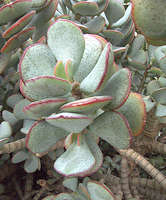
Cultivated plant, RBG Kew |
Crassula arborescens Willdenow 1798 (Silver Dollar, Silver Jade Plant)
This succulent shrub from the Eastern Cape has a thick, freely branching 6ft trunk of soft wood with thin, peeling bark. Branches are quite brittle but the fleshy, jointed stems root easily where they touch the ground. The glaucous-blue obovate leaves have reddened margins. The inflorescence is a cluster of white or pale pink star-like flowers, produced in Winter.
|
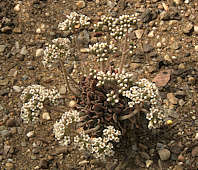
Cultivated plants |
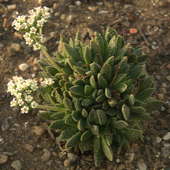
RBG Kew |
Crassula ausensis ssp. ausensis Hutchison 1952
A dwarf succulent plant with persistent obovate to oblanceolate leaves densely packed around the stem. The leaf surface may be patterned with whitish papillae. The inflorescence is a 3 - 4 inch stem, branching near the top and bearing a compact panicle of tubular white flowers with semi-fused petals.
Native to the succulent Karoo and Namibia. Several sub-species of this variable plant have been described.
|
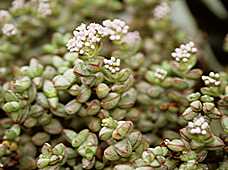
Crassula brevifolia Harvey 1862
The chunky obovate leaves are densely packed on the stem in opposite pairs. The leaves have flat upper surfaces with reddened margins, rounded lower surfaces and are lightly spotted in red. Clusters of white to pale pink flowers are produced at the stem tips in Autumn.
A plant of the succulent Karoo from the North-Western Cape of South Africa to Namibia.
Photograph: cultivated plant at RBG Kew.
|
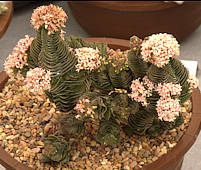
Crassula x "Buddha's Temple" Syn: Crassula x "Kimnachi"
This charming architectural plant is an artificial hybrid between C. perfoliata v. falcata x C. pyramidalis created by Myron Kimnach in 1959.
The greyish-green heart-shaped thickened leaves are densely stacked to form a square column up to 6 in tall. The leaf surface has a silvery-white dusting of powder which is liable to be washed off unless plants are watered only from below. With time, side branches may form along the column. Clusters of bright red flower buds are produced at the apex of the stems, opening to pale pink flowers.
|
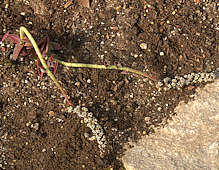
Cultivated plant RBG Kew |
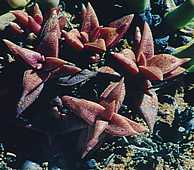
Habitat plant, Knersvlakte |
Crassula capitella Thunberg 1771
A small rosulate plant, solitary or clumping with lanceolate leaves reddening in the sun. The inflorescence is a dense spike of tiny white flowers.
This variable species incorporates many names formerly recognised as separate species and has several recognised sub-species, distributed across tropical East Africa, Namibia and South Africa.
|

Crassula coccinea Linneaus 1753 (Red Crassula)
This small succulent sub-shrub produces a cluster of stems up to 15 in tall. Pairs of succulent oval leaves are arranged along the stem in two overlapping ranks at 90 degrees to each other. Flat panicles of scarlet flowers are produced at the ends of the stems.
Native to South Africa.
|
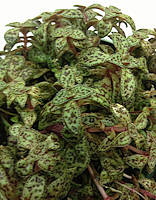
Crassula cooperi Regel 1874 Syn. (C. exilis ssp. cooperi (Regel) Toelken 1975)
A creeping dwarf succulent plant with reddish stems bearing spirally-arranged rosettes of fleshy, oblanceolate light green leaves bearing dark blotches and with a cillate margin. The plant forms a mat or low hummock with time.
Native to Southern Africa including mountains of the Transvaal. Hardy in climates with dry Winters but better under glass.
Photograph: Brian Shuya 2017
|
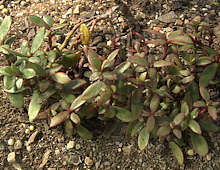
Crassula cultrata Linneaus 1771
This branching plant grows up to 3 ft tall as an under-storey plant in thickets. The obovate leaves are spread in pairs along the red stems. The inflorescence is a dense spike of tubular cream-coloured flowers.
A plant of the succulent Karoo in the South African Cape.
Photograph: cultivated plant at RBG Kew.
|
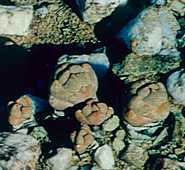
Habitat plant, van Rhyns Pass |
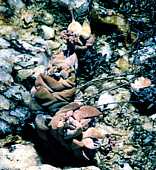
Habitat plant, Knersvlakte |
Crassula deceptor Schönland 1907
A dwarf columnar plant of the succulent Karoo, usually solitary or occasionally branched. The ovate-triangular grey-green leaves are tightly packed together and vary somewhat in shape.
Distributed in the succulent Karoo from Southern Namibia to the Northern Cape. Often associated with quartz gravel flats.
|
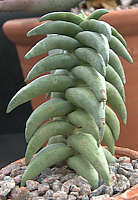
Crassula fusca Herre 1953
Name: Latin fuscus = dull brown, dusky (referring to the anthers ?)
This Crassula forms shrublets up to 15 in tall. The ovate leaves on small plants become narrower and lanceolate as the plant grows larger and colour up red in full sun. The inflorescence is a thyrse of white to cream-coloured flowers with black anthers, produced in mid-summer.
Native to North-Western slopes of mountains near the mouth of the Orange River in Cape Province and into South-West Namibia.
Photograph: cultivated plant at RBG Kew.
|
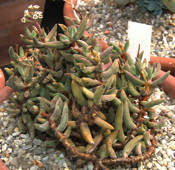
Crassula garibina Marloth & Schönland 1929
Name: from a native name "Gariep" = 'large' for the Orange River, referring to the plant's distribution
This Crassula makes a small sprawling shrublet with spreading branches bearing dull olive-green ovate leaves.
Native to mountains of the Richtersveld of South Africa and Namibia.
Photograph: cultivated plant at RBG Kew.
|
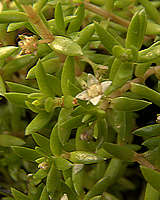
Crassula helmsii Cockayne 1907 (Australian Swamp Stonecrop, Pygmyweed)
This frost-hardy mat-forming Crassula is barely succulent and with insignificant white flowers has few redeeming qualities. Growing from fragments with a single node, it adapts to grow in shade or full sun in both moist soil or as free-floating mats clogging waterways. It is not difficult to find, even in some British nature reserves.
Native to Australia, Tasmania and New Zealand. Introduced into Great Britain in 1911, it has become naturalised in many temperate countries. Despite its invasive nature it is still sold as an oxygenating aquarium plant. It grows well outdoors in a shallow bowl without drainage.
|
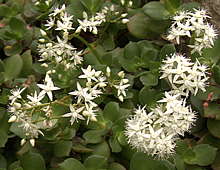
Crassula lactea Aiton 1789 (Taylor's Parches)
Syn. Toelkenia lactea
This trailing shrubby Crassula has brown stems bearing obovate leaves with a pointed tip. The upper surface of the leaf margin is marked with tiny white dots and some plants have reddened leaf margins. The branching inflorescence consists of clusters of fragrant white starry flowers on a long stalk.
Native to the South African Eastern Cape, Transvaal & Natal.
Photograph: cultivated plant at RBG Kew.
|
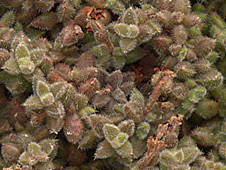
Crassula lanuginosa var. lanuginosa Harvey 1862
This protrate mat-forming plant has egg-shaped leaves covered in hairs. The leaves on the specimen illustrated are at the bottom end of the range (2 - 12 mm long) for this species and probably hairier than average, or perhaps the hairs don't grow in proportion to the leaf size.
Native to the Karoo of South Africa and Namibia. C. lanuginosa var. pachystemon has larger leaves.
Photograph: cultivated plant at RBG Kew.
|
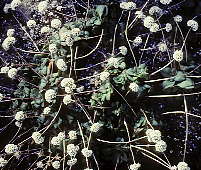
Crassula montana ssp. quadrangularis Tolken 1975
Syn. Crassula gillii Schönland 1907
The small, square rosettes formed from obovate leaves arranged oppositely, proliferate from their base to form dense mats. The tiny white flowers are formed into a globular head.
Native to the Western Cape of South Africa.
Photograph: cultivated plant at RBG Kew.
|
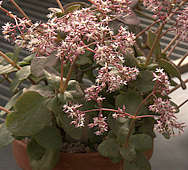
Cultivated plant, RBG Kew |
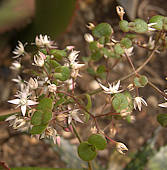
plantlets on inflorescence |
Crassula multicava Lemaire 1862 (Fairy Crassula)
Name: Latin multi = many + cava = hole, referring to many pores on the leaves.
The upper surface of the thin, rounded leaves surface is patterned with hydathodes (water absorbing or secreting pores) which allow the leaves to absorb moisture from fogs and dews. The branching inflorescence makes a spray of tiny pale pink, star-like flowers. Small plantlets sometimes form in the flower axils.
Crassula multicava is native to the Eastern Cape of South Africa, Natal and Mpumulanga. This common window-ledge plant is readily propagated from cuttings, even single leaves, or plantlets from the inflorescence.
|
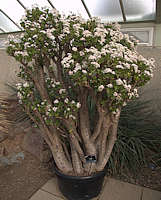
Cultivated plant RBG Kew |
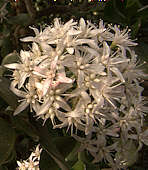 |
Crassula ovata Druce 1917 (Jade Plant, Money Plant)
Syn. C. argentea, C. portulaca
This is probably the best known Crassula as it tolerates a certain amount of neglect. Specimens are seen on window-ledges and in offices everywhere. With proper care the plant can become a large 6-8 ft shrub, with fragrant flowers during the Winter, if kept just frost free. The thick stems branch sparingly at the base, but more freely as the plant matures. The brittle, jointed stems have obovate green leaves, becomming reddened in full sun. Native to the Western Cape of South Africa.
More about Jade Plants
|
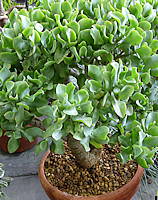
Crassula ovata - selected cultivars
C. ovata c.v. 'Blue Surprise' - thin curled blue-green leaves. (Right)
C. ovata c.v. 'Crosby's Compact' - a dwarf cultivar.
C. ovata c.v. 'Gollum' - a monstrose cultivar with nearly tubular leaves whose ends are indented.
C. ovata c.v. 'Hobbit' - somewhat flatter curled leaves.
C. ovata c.v. 'Hummel's Sunset' - brightly coloured red, yellow and green leaves when grown in full sun.
C. ovata c.v. 'Lemon & Lime' - a variegated cultivar with marbled leaves.
C. ovata c.v. 'Pink Beauty' - clusters of pink flowers in early Winter.
C. ovata c.v. 'Red Horn' - brightly coloured red and yellow tips to green tubular leaves.
C. ovata c.v. 'Skinny Fingers' - finger-like leaves whose ends are pointed.
|
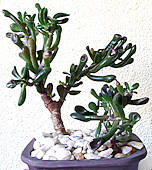
Left: Crassula ovata c.v. 'Gollum' Hort
This small shrubby succulent plant has nearly tubular leaves whose ends are indented like a suction cup. Flowers are similar to those of C. ovata. This plant may be a monstrose cultivar of C. ovata or a hybrid: Crassula argentea x C. lactea.
Large numbers of these plants are propagated in the horticultural trade.
Picture: José Carlos Ibar Cuerda 2010
|
|
Crassula pellucida Linnaeus 1753
Reddish stems bear decussate pairs of thickened ovate green leaves, with reddish margins in full sun. The inflorescence is a rounded panicle of many small white flowers tinged with pink.
Native to the Western and Eastern Cape of South Africa. Several selected forms are in circulation.
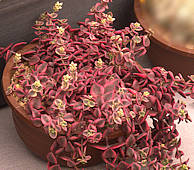 Left: Crassula pellucida ssp. marginalis f. rubra (Aiton) Toelken 1975
Left: Crassula pellucida ssp. marginalis f. rubra (Aiton) Toelken 1975
Syn: Crassula mariginalis variegata
This succulent plant forms a cascading mass of fleshy red, green and lemon variegated leaves.
|
|
Crassula perfoliata Linneaus 1753 Syn. Crassula falcata Wendland 1798
A shrubby plant growing up to 2-3 ft tall. The panicle of bright red flowers contrasts splendidly with the gray-green foliage. Leaves are lanceolate to triangular-lanceolate. Varieties with white and pink flowers also occur less commonly.
Native to the Eastern Cape of South Africa.
|
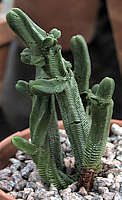
Crassula pyramidalis Thunberg 1778
An upright to sprawling plant with triangular scale-like leaves tightly packed in four ranks around the stem to give an overall quadrangular, neat, almost mossy appearance. Cultivated plants are usually greener than those in habitat.
A plant of the succulent Karoo in the South African Cape.
Phoptograph: RBG Kew
|
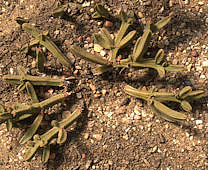
Crassula pyramidalis var. scabrispina Thunberg 1778
A sprawling plant with triangular scale-like leaves tightly packed in four ranks around the stem to give an overall quadrangular, neat, almost mossy appearance. The green plant adopts a bronze colour in full sun.
A plant of the succulent Karoo in the South African Cape.
Photograph: RBG Kew.
|
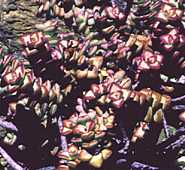
Crassula rupestris Thunberg 1778
A succulent shrub with flattened succulent leaves basally fused in pairs around the branching stem. The upper leaf surface is slightly concave with a convex underside. Leaf margins redden in full sun but otherwise leaves are grey-green.
Native to the Nothern Cape of South Africa into Namibia.
Photograph: Karoo Botanic Garden RSA
|
|
Crassula rupestris ssp. marneriana Tölken 1975
Syn. Crassula marneriana Huber & Jacobsen 1951
A small, prostrate variety of C. rupestris. The leaves are thicker and pairs fused into rounded discs, tightly packed around the branching stem to give an overall rounded structure. The leaf margins reddens in full sun.
A plant of the succulent Karroo of the Western Cape.
Photograph: Cultivated plants at RBG Kew.
|
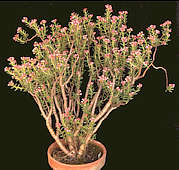
Crassula sarcocaulis Ecklon & Zeyher 1837
This hardy sub-shrub has a profusion of small pink flowers during the summer. Possibly the only Crassula able to withstand the cold-wet English Winter, given a sunny position and well drained soil. It can also be treated as a bonsai and pruned to make a very nice specimen up to 12 inches tall. Any little bit of stem stuck in the soil will root and grow into another plant. Deserves to be more widely grown.
Distributed from the Eastern Cape of South Africa to Malawi and Zimbabwe. Crassula sarcocaulis ssp. sarcocaulis grows in the Drakensberg mountains.
A white-flowered form (C. sarcocaulis alba) is in cultivation.
|
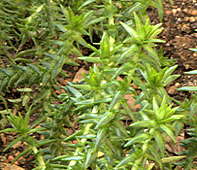
Crassula schimperi ssp. schimperi Gilbert 2000
Syn. Tillaea pentandra Royle 1846
Crassula schimperi grows as a sprawling mat of succulent green stems with lanceolate leaves. The stems become brown and woody with age.
Widely distributed in mountains up to 13,000 ft from East Africa to Yemen, Bhutan, India, Pakistan and China.
Photograph: University of Oxford Botanic Gardens
|
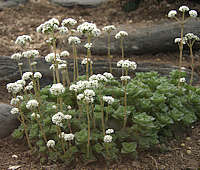
Crassula socialis Schönland 1929
Square rosettes, formed from four ranks of triangular leaves, proliferate at their base to form dense mats. The inflorescence is produced in the Spring to early Summer and consists of one or more rounded heads of many tiny tubular white flowers on a relatively long, branching stem.
Grows among rocks in the Eastern Cape of South Africa. Not cold-wet hardy but tolerates a cold dry Winter.
Photograph: RBG Kew.
|
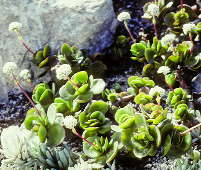
Crassula swaziensis Schönland 1897
A low-growing plant with rounded flat green leaves packed around the stem, but with an open appearance. Flowers in late Summer to Autumn with rounded heads of many tiny tubular white flowers on a relatively long stem.
Distributed in bushveld and grassland of Zimbabwe, and North-Eastern South Africa.
Photograph: RBG Kew.
|
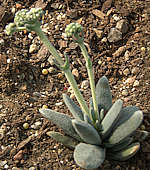
Crassula tecta Thunberg 1778
A dwarf mostly solitary succulent, occasionally branching. A small rosette is formed from ovate, grey leaves with a papillate surface. Flowers in winter with a globular cluster of small, tubular cream flowers.
A plant of the succulent Karoo of the Western Cape of South Africa.
Photograph: RBG Kew.
|
Cultivation
While Crassulaceae will generally tolerate a wide range of light levels, the compact growth and leaf colouration seen in their habitat requires high light levels, preferably direct sunlight. Jade plants and other tender species enjoy a sunny position on the patio during the summer. As with other succulents a gritty potting medium is suitable. Overwatering encourages roots and lower stems to rot. If this happens, the stem should be cut back to healthy tissue, dried off for a couple of weeks and replanted in a dryish free-draining potting mixture. Many species will re-root easily.
In frost-free Mediterranean climates, many Crassulas are suitable for the garden. There are few truly hardy Crassulas suitable for the British garden and similar climates with cold-wet winters, although C. sarcocaulis is a fully hardy exception.
The main pests are root and stem mealy bugs. Crassulaceae were generally intolerant of many older insecticides, especially Malathion. I have seen no adverse reaction from watering Crassulaceae with systemic insecticides based on Imidacloprid e.g. Provado Vine Weevil Killer. This will protect against many insect pests but has little effect on red spider mites. Prophylactic treatment with Imidacloprid is advisable if plants grown outside during the summer are brought indoors.
|





































